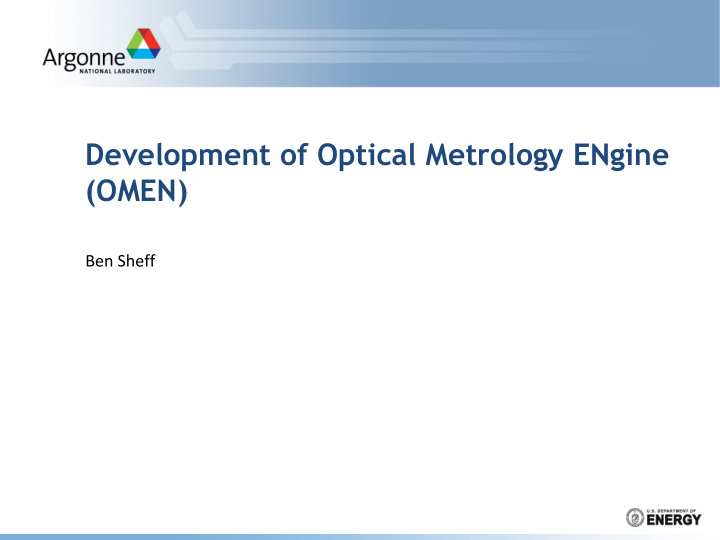



Development of Optical Metrology ENgine (OMEN) Ben Sheff
Introduction APS is a 7 GeV, storage-ring-based hard x-ray synchrotron radiation source at Argonne National Laboratory – Funded by DOE Office of Science, Basic Energy Sciences Produces collimated, intense beams of hard x-ray radiation – Useful for a variety of applications – Requires advanced optics to manipulate Image courtesy of https://www1.aps.anl.gov/About/Welcome 2
X-ray Mirrors As beamlines get better, need better mirrors – Residual slope error as low as 50 nrad Autocollimator-based Long trace profiler (AC-LTP) is a high precision metrology tool 1,2 – Measures slope of mirror at each point to within 50 nrad – Extremely accurate for small range of angles, but has problems farther out – New analysis tools needed to handle this 3
Analysis Software Developed Optical Metrology ENgine (OMEN) in Python Handles standard analysis – Easy, dynamic filtering – Fitting options, with live-updated residue plot – Region-of-interest selection Tools to deal with high angles – Stitching together overlapped, adjacent scans of mirror segments – Adding calibration run 4
Object Oriented Design OMEN class handles GUI and manages companion classes Three companion classes – Raven handles data collection and most processing – Lightning handles stitching and mirror profile comparison – Medium handles input/output standard formats Easy to modify, and to re-use parts for other purposes OMEN Lightning Raven Medium1 Image courtesy of Lyoha123, Image courtesy of Image courtesy of Sid uploaded to Wikimedia commons Blazon.com/heraldry/ Meier’s Civilization V 5
OMEN in Action 6
Dealing with Highly Curved Mirrors Preliminary Work: Take overlapping partial scans and stitch together – Each scan over a small region over which the mirror is roughly linear – Tilt mirror so the scan center is horizontal – Use Lightning to stitch together partial scans – Compare the result with full scan 7
Calibration Significant deviation between stitched and non-stitched – Seems to correlate with angle measured New high precision small angle generator against which to calibrate 3 – Accurate on the order of 10 nrad Tested small calibration run – Inverted and interpolated data to make a look-up table – Further investigation warranted, with more accurate measurements 8
Conclusions and Future Direction Code is robust, and will be useful for future analysis – Easy to use – Rapid analysis Stitching code allows for new measurement capability Further investigation will be conducted into calibration in the future – More accurate measurements needed Some known systematic errors introduced by analysis have yet to be corrected – eg., All interpolation is simple linear as of yet http://img2.goodfon.su/original/2048x1360/7/39/dorog a-vdal-povorot-izgib.jpg 9
Acknowledgements Lee Teng Undergraduate Fellowship for their generous sponsorship and for granting me the opportunity to take part in this research. My mentor, Dr. Assoufid for welcoming me into his group, and being willing to meet me almost every day to discuss my project. Jun Qian and Joe Sullivan for their work building, programming, and operating the equipment, and for helping me understand what the data was and how to work with it. The Optics Group in the X-ray Science Division of the Advanced Photon Source at Argonne National Laboratory, and Argonne National Laboratory itself for hosting me for the summer. 10
References 1 Lahsen Assoud et al., Nucl. Instrum. Methods A 710, 31-36 (2013). 2 J. Qian, J. Sullivan, M. Erdmann, A. Khounsary, L. Assoud, Nucl. Instrum. Methods A 710, 48-51 (2013). 3 D. Shu, J. Qian, W. Liu, S. Kearney, J. Anton, J. Sullivan, and L. Assoud, Proc. SPIE 9206, Advances in Metrology for X-Ray and EUV Optics V, 920601 (October 7, 2014); doi: 10.1117/12.2084726Proc. of SPIE Vol. 9206 11
Questions 12
Recommend
More recommend